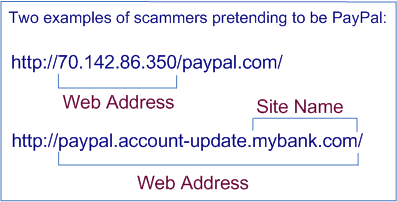One way to protect yourself against internet scams is to understand how to spot a fake address.
Looking at the address bar can help you determine whether or not a website is legitimate.
Breakdown of a URL

Some tricks scammers use
- Concealed web addresses – a link that looks legitimate but isn’t
- Misleading addresses – a URL that looks very similar to a legitimate website
- Fake email addresses – the “From” field in an email message is forged
Steps to recognize a fake address
Hover before you click - links aren’t always what they seem
- Most web browsers and email programs will reveal the underlying URL when you hover the cursor over the link. The actual URL will appear in the browser or status bar and you can verify where you’re going before you click.
Examine the URL closely – fake websites often closely resemble legitimate ones. The website is likely fake if:
- The URLs contains all numbers in the beginning
- The URL contains the "@" sign in the middle of the address
- There are spelling mistakes in the Web address (e.g., PaPyal v. PayPal)
Google the company to confirm the real web address
Verify the security of the website
- URL should begin with “https://”
- There will be a padlock icon somewhere in the browser window that is a link to security information.
